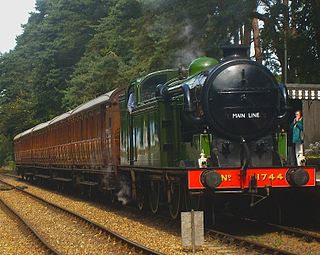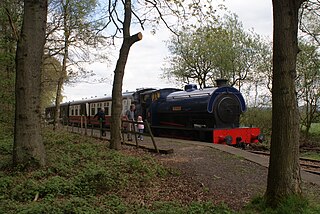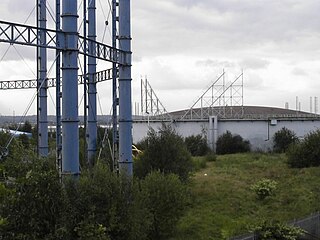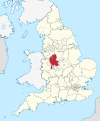The Foxfield Light Railway Society
The society was formed in 1967 to preserve any railway artifacts irrespective of their origins and to operate them on the line that originally connected the former Foxfield Colliery in Dilhorne, Staffordshire, with the Stoke on Trent to Derby line of the former North Staffordshire Railway at Blythe Bridge.
The society became a company, limited by guarantee in 1972. It was granted charitable status by the Inland Revenue at that time. It has no shareholders and each Full Member has a liability limited to £5.
From January 2009 it has been registered with the Charity Commissioners as a registered charity in its own right and as a former constitution.
In 1995 after 28 years of operation, the company was awarded a light railway order, the Foxfield Light Railway Order 1995 (SI 1995/1236) under the Light Railways Act 1896. This gave it statutary powers as defined in the order to build and operate a railway and buildings. Before this time it had simply taken over the "grandfather rights" of its former owners. An important reference in the order is to the Railways Clauses Consolidation Act 1845. This empowers the company to erect such buildings and structures as necessary for the operation of its line, without having to seek planning permission from the local authority.
The company has operated on a volunteer basis since 1967, but some paid staff also work.

The North Norfolk Railway (NNR) – also known as the "Poppy Line" – is a 5+1⁄4-mile (8.4 km) heritage steam railway in Norfolk, England, running between the towns of Sheringham and Holt. The North Norfolk Railway is owned and operated as a public limited company, originally called Central Norfolk Enterprises Limited. The railway is listed as exempt from the UK Railways (Interoperability) Regulations 2000.

The North Staffordshire Railway (NSR) was a British railway company formed in 1845 to promote a number of lines in the Staffordshire Potteries and surrounding areas in Staffordshire, Cheshire, Derbyshire and Shropshire.
Blythe Bridge is a village in Staffordshire, England, south-east of Stoke-on-Trent.

The Churnet Valley Railway is a preserved standard gauge heritage railway in the Staffordshire Moorlands of Staffordshire, England. It operates on part of the former Churnet Valley Line which was opened by the North Staffordshire Railway. The railway is roughly 10.5 miles (16.9 km) long from Kingsley and Froghall to Ipstones. The land from Leek Brook Junction to Ipstones was opened by Moorland & City Railways (MCR) in 2010 after they took a lease out from Network Rail. This has subsequently been purchased by the Churnet Valley Railway. The main stations along the line are Kingsley and Froghall, Consall, Cheddleton and Leek Brook. Work has begun to extend the line to the town of Leek which will act as the northern terminus of the line. The line between Leek and Waterhouses has also been reopened as part of the heritage railway as far as Ipstones.

Cheadle is a market town and civil parish in the Staffordshire Moorlands District of Staffordshire, England, with a population of 12,000 at the 2021 census. It is located between Uttoxeter, Leek, Ashbourne and Stoke-on-Trent.
The Stafford and Uttoxeter Railway was authorised by Act of Parliament on 29 July 1862, to build a line between the towns of Stafford and Uttoxeter in Staffordshire, England. It opened for traffic in 1867. It opened on 23 December 1867. Construction cost had much exceeded estimates, and income was poor, so that the company was always in financial difficulty. It was placed in receivership in 1875. The Great Northern Railway (GNR) had running powers to Uttoxeter and was persuaded to acquire the company, which it did in 1881. The GNR spent a considerable sum on improving the line, but it never made money and it was closed to passengers on 4 December 1939. Goods traffic ceased in 1951, except for a short stub to RAF Stafford; this too closed in 1975.

Uttoxeter railway station serves the town of Uttoxeter, Staffordshire, England. It is on the Crewe–Derby line, which is also a Community rail line known as the North Staffordshire line. The station is owned by Network Rail and managed by East Midlands Railway.

The Foxfield Railway is a preserved standard gauge line located south east of Stoke-on-Trent. The line was built in 1893 to serve the colliery at Dilhorne on the Cheadle Coalfield. It joined the North Staffordshire Railway line near Blythe Bridge. It is open at weekends and operates trains on Sundays, Bank Holidays and some Saturdays from April to October and Santa Special trains in December. It is home to the Knotty Coach Trust, The Foxfield Miniature Railway, a museum, café, bar, shop and hosts visits from the adjacent Olcote Animal Sanctuary the first three Sundays in a month.
The Wrexham and Minera Railway or Wrexham and Minera Branch was a railway line in North Wales between the city of Wrexham, the village of Brymbo where it served the Brymbo Steelworks, and the lead mines and limeworks at Minera. A further branch ran from Brymbo to Coed Talon, where it connected with lines to Mold. The system was constructed in several stages between 1844 and 1872, while the various lines making up the system closed in 1952, 1972 and 1982.
The Derbyshire and Staffordshire extension of the Great Northern Railway was an English railway network built by the GNR to get access to coal resources in the area to the north and west of Nottingham. The Midland Railway had obstructed the GNR in its attempts to secure a share of the lucrative business of transporting coal from the area, and in frustration the GNR built the line. The line was forked: it reached Pinxton in 1875 and a junction with the North Staffordshire Railway at Egginton, approaching Burton on Trent in 1878. The line cut through Derby, resulting in considerable demolition of housing there.

Blythe Bridge railway station in Blythe Bridge, Staffordshire, England, is served by trains on the Crewe to Derby Line; it is also a Community rail line known as the North Staffordshire line. The station is owned by Network Rail and managed by East Midlands Railway. The full range of tickets for travel are purchased from the guard on the train at no extra cost.

The Crewe–Derby line is a railway line in central England, running from Crewe in a south-easterly direction to Derby, via Stoke-on-Trent and Uttoxeter. Passenger services on the line are provided by East Midlands Railway.

Rail transport in Staffordshire has a long history. Stafford itself is a major "crossroads" on the West Coast Main Line, handling passenger and freight services between London and Scotland along with traffic travelling between Manchester and Birmingham. Stoke-on-Trent was once a major railway centre, especially for traffic associated with the coal mining and pottery industries, but in recent years this traffic has almost completely disappeared.

Dilhorne is an ancient parish and village in Staffordshire, three miles from Cheadle and six miles from Stoke-on-Trent. The village is within the Staffordshire Moorlands area.

Swan Village Gas Works, is a historical manufacturing plant in West Bromwich for the production of coal gas, or "town gas". The works are situated in Swan Village, a part of West Bromwich in the metropolitan borough of Sandwell. Most of the works have been demolished although a few relics survive. Parts of the works are still in operation as part of the National Grid.
The Cheadle branch line was a railway line of just under 4 miles (6.4 km) in length that served the town of Cheadle, Staffordshire. It was in operation as a passenger line from 1892 to 1963, and closed altogether in 1986. It took 46 years from conception to completion and was notable in that part of the line had to be practically rebuilt partway through its existence.

The Cheadle Coalfield is a coalfield in the United Kingdom. Centred on the town of Cheadle, Staffordshire and its outlying villages it lies to the east of Stoke-on-Trent and the much larger North Staffordshire Coalfield. The area has been mined for many years, with documentary evidence from Croxden Abbey citing coal mining in the 13th century.
The Churnet Valley line was one of the three original routes planned and built by the North Staffordshire Railway. Authorised in 1846, the line opened in 1849 and ran from North Rode in Cheshire to Uttoxeter in East Staffordshire. The line was closed in several stages between 1964 and 1988 but part of the central section passed into the hands of a preservation society and today operates as the Churnet Valley Railway.
Meaford Power Station was a coal-fired power station situated on the River Trent at Meaford near Stone in Staffordshire.
The Leen Valley lines of the Great Northern Railway were railway branch lines built to access the collieries in the Nottinghamshire coalfield in England. The Midland Railway had long been dominant in the area, but there was resentment against its monopolistic policies from coalowners, who encouraged the Great Northern Railway to build a line. The Leen Valley Line was opened in 1881; it ran as far as Annesley colliery. A passenger service was run the following year, and very considerable volumes of coal were hauled.












